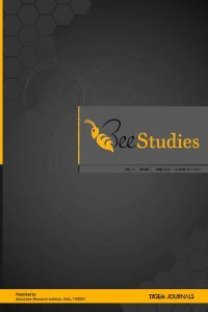The Effects of Sugar Syrup Enriched with Amino Acid Mixtures at Different Concentrations on Colony Population Dynamics and Development Characteristics of Bumble bee (Bombus terrestris)
Amino acid Bombus terrestris Colony development traits Feeding, Amino acid Bombus terrestris Colony development traits Feeding, Bombus terrestris, Bombus terrestris, Colony development traits, Feeding
The Effects of Sugar Syrup Enriched with Amino Acid Mixtures at Different Concentrations on Colony Population Dynamics and Development Characteristics of Bumble bee (Bombus terrestris)
Amino acid, Bombus terrestris, Colony development traits, Feeding,
___
- Amin, M. R., Than, K. K., & Kwon, Y. J. (2010). Mating status of bumblebees, Bombus terrestris (Hymenoptera: Apidae) with notes on ambient temperature, age and virginity. Applied Entomology and Zoology, 45(3), 363-367. https://doi.org/10.1303/aez.2010.363
- Baloglu, G. H., & Gurel, F. (2015). The effects of pollen protein content on colony development of the bumblebee, Bombus terrestris L. Journal of Apicultural Science, 59(1), 83-88. https://doi.org/10.1515/jas-2015-0009
- Beekman, M., & van Stratum, P. (2000). Does the diapause experience of bumblebee queens Bombus terrestris affect colony characteristics? Ecological Entomology, 25(1), 1-6. https://doi.org/10.1046/j.1365- 2311.2000.00235.x
- Brodschneider, R., & Crailsheim, K. (2010). Nutrition and health in honey bees. Apidologie, 41(3), 278-294. https://doi.org/10.1051/apido/2010012 Cnaani, J., Robinson, G. E., & Hefetz, A. (2000). The critical period for caste determination in Bombus terrestris and its juvenile hormone correlates. Journal of Comparative Physiology A, 186(11), 1089-1094. https://doi.org/10.1007/s003590000163
- Duchateau, M. J., & Velthuis, H. H. W. (1988). Development and reproductive strategies in Bombus terrestris colonies. Behaviour, 107(3-4), 186-207. https://doi.org/10.1163/156853988X00340
- Duchateau, M. J., Velthuis, H. H., & Boomsma, J. J. (2004). Sex ratio variation in the bumblebee Bombus terrestris. Behavioral Ecology, 15(1), 71-82. https://doi.org/10.1093/beheco/arg087
- Gosterit, A., Galic, A., & Gurel, F. (2009). The effect of queen removal on sexual production in the bumble bee, Bombus terrestris (Hymenoptera: Apidae). Turkish Journal of Zoology, 33(4), 403-407. https://doi.org/10.3906/zoo-0807-34
- Gosterit, A. (2011). Effect of different reproductive strategies on colony development characteristics in Bombus terrestris L. Journal of Apicultural Science, 55(2), 45-51.
- Gosterit, A. (2016). Adverse effects of inbreeding on colony foundation success in bumblebees, Bombus terrestris (Hymenoptera: Apidae). Applied Entomology and Zoology, 51(4), 521-526. https://doi.org/10.1007/s13355-016-0427-2
- Gosterit, A., & Baskar, V. C. (2016). Impacts of commercialization on the developmental characteristics of native Bombus terrestris (L.) colonies. Insectes Sociaux, 4(63), 609-614. https://doi.org/10.1007/s00040-016-0507-x
- Gosterit, A., & Gurel, F. (2016). Male remating and its influences on queen colony foundation success in the bumblebee, Bombus terrestris. Apidologie, 47(6), 828- 834. https://doi.org/10.1007/s13592-016-0438-6
- Gosterit, A., & Cicek, G. O. (2017). Effects of vitamin additive diets on colony foundation success in bumblebee, Bombus terrestris. Scientific Papers. Series D. Animal Science, 60, 240-243.
- Gurel, F., Gosterit, A., & Eren, O. (2008). Life-cycle and foraging patterns of native Bombus terrestris (L.) (Hymenoptera, Apidae) in the Mediterranean region. Insectes Sociaux, 55(2), 123-128. https://doi.org/10.1007/s00040-008- 0984-7
- Heinrich, B. (1979). Bumblebee economics Harvard University Press. Cambridge, Massachusetts, USA.
- Herbert JR, E. W., & Shimanuki, H. (1978). Effect of fat soluble vitamins on the brood rearing capabilities of honey bees fed a synthetic diet. Annals of the Entomological Society of America, 71(5), 689-691. https://doi.org/10.1093/aesa/71.5.689
- Holland, J. G., Guidat, F. S., & Bourke, A. F. (2013). Queen control of a key life-history event in a eusocial insect. Biology Letters, 9(3), 20130056. https://doi.org/10.1098/rsbl.2013.0056
- Kumova U., 2000. Feeding effection on colony development and honey production of honeybee (Apis mellifera L.) colonies, Journal of Animal Production, 41, 55-64.
- Plowright, C. M. S., & Plowright, R. C. (1999). Resource management in bumble bee colonies. Insect population growth and the environment. Research Signpost, Trivandrum, India, 21-28.
- Plowright, R. C., & Pendrel, B. A. (1977). Larval growth in bumble bees (Hymenoptera: Apidae). The Canadian Entomologist, 109(7), 967-973. https://doi.org/10.4039/Ent109967-7
- Ribeiro, M. F., Duchateau, M. J., & Velthuis, H. H. W. (1996). Comparison of the effects of two kinds of commercially available pollen on colony development and queen production in the bumble bee Bombus terrestris L. (Hymenoptera, Apidae). Apidologie, 27(3), 133-144. https://doi.org/10.1051/apido:19960302
- Schmid‐Hempel, R., & Schmid‐Hempel, P. (1998). Colony performance and immunocompetence of a social insect, Bombus terrestris, in poor and variable environments. Functional Ecology, 12(1), 22-30. https://doi.org/10.1046/j.1365-2435.1998.00153.x Sutcliffe, G. H., & Plowright, R. C. (1990). The effects of pollen availability on development time in the bumble bee Bombus terricola K. (Hymenoptera: Apidae). Canadian Journal of Zoology, 68(6), 1120-1123. https://doi.org/10.1139/z90-166
- Velthuis, H. H., & van Doorn, A. (2006). A century of advances in bumblebee domestication and the economic and environmental aspects of its commercialization for pollination. Apidologie, 37(4), 421-451. https://doi.org/10.1051/apido:2006019
- ISSN: 2757-5438
- Yayın Aralığı: Yılda 2 Sayı
- Başlangıç: 2009
- Yayıncı: Arıcılık Araştırma Enstitüsü Müdürlüğü
Selcan TİMUROĞLU, İsmail Yaşhan BULUŞ, Ayhan GÖSTERİT
Analysis of Honey Export Potential and Competitiveness of Türkiye
Molecular Characterization of the Honeybee (Apis mellifera) from two Vegetational Zones in Nigeria
Afeez Tope NASİRUDEEN, Michael AWODİRAN, Tofunmi OLADİMEJİ
An Overview on the Effects of Propolis Administration in Different Branches of Livestock Production
